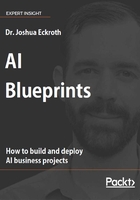
Preface
Artificial intelligence (AI) is the hot new thing. Though AI has been around for 50 years, recent dramatic advances in the kinds of problems it can solve and the availability of open source software have opened it up to all programmers and organizations. AI technology can magnify the capabilities of an organization and its software, or open entirely new pursuits. For example, in Chapter 5, A Blueprint for Detecting Your Logo in Social Media, we show how to use deep learning to detect a company's logos in photos shared publicly on Twitter. Without such an AI tool, these photos would probably never be noticed, and the company would not be able to identify how their products and services connect with individuals' everyday lives. The data is there. Twitter, Reddit, news services, and others have public APIs that expose their continuous feeds of comments, photos, videos, news articles, and more. But nobody has time to look at all of that, and searches and filters do not work on photos. AI completely changes the rules.
My goal with this book is to change your expectation of where AI can be used in your applications, while giving you the power to build your own AI-powered applications. By covering a broad range of applications and technologies, I hope to show that there is not one single kind of AI (such as deep learning), nor a single kind of application.
We cover applications in planning (Chapter 2, A Blueprint for Planning Cloud Infrastructure), natural language processing (Chapter 3, A Blueprint for Making Sense of Feedback and Chapter 7, A Blueprint for Understanding Queries and Generating Responses), recommendation engines (Chapter 4, A Blueprint for Recommending Products and Services), deep learning (Chapter 5, A Blueprint for Detecting Your Logo in Social Media), logic programming (Chapter 7, A Blueprint for Understanding Queries and Generating Responses), and trend and anomaly detection (Chapter 6, A Blueprint for Discovering Trends and Recognizing Anomalies).
These applications show AI can help an organization with logistics and automation, customer relations, and marketing. These applications are not designed to replace human workers – instead, each project automates tedious aspects of work and provides new insights to knowledge workers. For example, Chapter 3, A Blueprint for Making Sense of Feedback shows how to analyze social media comments and news articles to gather detailed data about sentiment (positive or negative) about certain topics of interest. With this data, marketing experts can gauge whether a marketing campaign was successful, for example, or make an informed judgment about when to introduce a new product.
The time for AI is now. We are presently in an era where the (justified) hype for AI is strong. Consider these hypothetical headlines: "Hospital begins using AI to help with cancer diagnosis," "University uses AI to ensure on-time graduation," "Marketing firm builds AI to better target consumers," "Airline streamlines boarding process with AI." Each headline refers to some improvement, and AI is suggested to be the cause of the improvement. But what if we had replaced "uses AI" or "builds AI" with "adds staff" or "hires firm"? For example, "Airline streamlines boarding process with more gate agents and roped walkways..." It would feel like more of the same, not a revolutionary new approach.
There is something about AI that gives it a mysterious, optimistic, dreamy quality. AI can do anything! And whatever it does, it will be completely novel! Even if AI determined that a streamlined airplane boarding process can be accomplished by more roped walkways, travelers would likely marvel at the result.
"AI found this to be the optimal configuration!" In some sense, the more alien the result, the more likely we are to believe it came from AI and it is indeed optimal.
But they're not wrong. AI is different. AI is perpetually new. AI always promises that something we could not do yesterday can now be done with ease. Again, they're not wrong, though the hype can run away with itself sometimes.
I hope this book shows that AI is the future, it is available now, and it is here to stay.